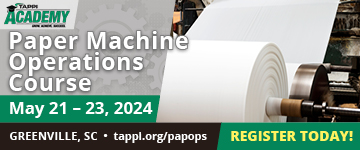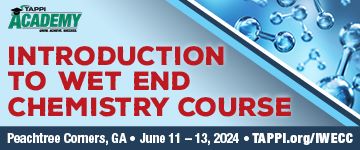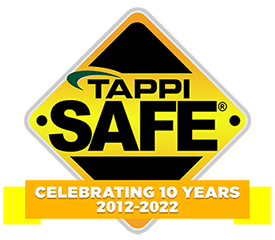 Search
Search
Use the search bar or filters below to find any TAPPI product or publication.
Filters
Content Type
Publications
Level of Knowledge
Collections
Magazine articles

Challenges and opportunities for china's paper industry, TAPPI JOURNAL, October 2000, Vol. 83(10)
Challenges and opportunities for china's paper industry, TAPPI JOURNAL, October 2000, Vol. 83(10)
Magazine articles

UGA warnell school of forest resources builds mobile lab for wastewater analyses and management, TAPPI JOURNAL, December 1999, Vol. 82(12)
UGA warnell school of forest resources builds mobile lab for wastewater analyses and management, TAPPI JOURNAL, December 1999, Vol. 82(12)
Journal articles

Magazine articles

Pareto-based design of experiments for identifying and comparing optimum sealing parameters of heat sealing applications in packaging machines, TAPPI Journal June 2023
ABSTRACT: Sealing is one of the most important process steps in industrial packaging, because the sealed seam is the most sensitive section of a package in terms of quality. For this reason, a major focus in flexible packaging is the sealing process, and among this, heat sealing is the most frequently used technology. In detail, applications of heat sealing processes are confronted with four conflicting objectives: increasing seam quality, reducing dwell time, reducing sealing temperature, and increasing process robustness towards varying conditions. Typical problems, such as identification of the optimum process parameters or selection of the most appropriate packaging film, are subject to these conflicting objectives.This paper presents a recently published design of experiments for characterizing and comparing heat sealing properties of packaging films based on a multi-objective optimization algorithm. The approach provides easy-to-read charts showing all optimum sealing parameters with regard to the four essential objectives of heat sealing: seam quality, dwell time, sealing temperature, and process robustness. Three case studies show exemplary applications of the new approach: 1) analyzing transport damages of beverage powder packages; 2) identifying and comparing optimum sealing parameter of a standard, mono-material, and fiber based packaging film regarding tightness and visual properties of the produced sachets; and 3) analyzing the effect of additional aluminum layers on sealing characteristics regarding hot-tack.The new design of experiments may provide the basis of a standard test method for the identification of optimal sealing parameters in the heat sealing processes.
Journal articles

Magazine articles

Predicting strength characteristics of paper in real time using process parameters, TAPPI Journal March 2022
ABSTRACT: Online paper strength testing methods are currently unavailable, and papermakers have to wait for manufacture of a complete reel to assess quality. The current methodology is to test a very small sample of data (less than 0.005%) of the reel to confirm that the paper meets the specifications. This paper attempts to predict paper properties on a running paper machine so that papermakers can see the test values predicted in real time while changing various process parameters. This study was conducted at a recycled containerboard mill in Chicago using the multivariate analysis method. The program provided by Braincube was used to identify all parameters that affect strength characteristics. Nearly 1600 parameters were analyzed using a regression model to identify the major parameters that can help to predict sheet strength characteristics. The coefficients from the regression model were used with real-time data to predict sheet strength characteristics. Comparing the prediction with test results showed good correlation (95% in some cases). The process parameters identified related well to the papermaking process, thereby validating the model. If this method is used, it may be possible to predict various elastic moduli (E11, E12, E22, etc.) in the future as the next step, rather than the traditional single number “strength” tests used in the containerboard industry, such as ring crush test (RCT), corrugating medium test (CMT), and short-span compression strength test.
Journal articles

Magazine articles

Creating adaptive predictions for packaging-critical quality parameters using advanced analytics and machine learning, TAPPI Journal November 2019
ABSTRACT: Packaging manufacturers are challenged to achieve consistent strength targets and maximize pro-duction while reducing costs through smarter fiber utilization, chemical optimization, energy reduction, and more. With innovative instrumentation readily accessible, mills are collecting vast amounts of data that provide them with ever increasing visibility into their processes. Turning this visibility into actionable insight is key to successfully exceeding customer expectations and reducing costs. Predictive analytics supported by machine learning can provide real-time quality measures that remain robust and accurate in the face of changing machine conditions. These adaptive quality “soft sensors” allow for more informed, on-the-fly process changes; fast change detection; and process control optimization without requiring periodic model tuning.The use of predictive modeling in the paper industry has increased in recent years; however, little attention has been given to packaging finished quality. The use of machine learning to maintain prediction relevancy under ever-changing machine conditions is novel. In this paper, we demonstrate the process of establishing real-time, adaptive quality predictions in an industry focused on reel-to-reel quality control, and we discuss the value created through the availability and use of real-time critical quality.
Journal articles

Magazine articles

Effects of different ammonium lignosulfonate contents on the crystallization, rheological behaviors, and thermal and mechanical properties of ethylene propylene diene monomer/polypropylene/ammonium lignosulfonate composites, TAPPI Journal January 2020
ABSTRACT: Thermoplastic elastomer (TPE), made from ethylene propylene diene monomer (EPDM) and polypropylene (PP) based on reactive blending, has an excellent processing performance and characteristics and a wide range of applications. However, there are currently no reports in the literature regarding the usage of TPE in making composite boards. In this paper, EPDM, PP, and ammonium lignosulfonate (AL) were used as the raw materials, polyethylene wax was used as the plasticizer, and a dicumyl peroxide vulcanization system with dynamic vulcanization was used to make a new kind of composite material. This research studied the influences of the AL contents on the crystallization behaviors, rheological properties, thermal properties, and mechanical properties of the composites. The results showed that the AL content had a noticeable impact on the performance of the composite board. Accordingly, this kind of composite material can be used as an elastomer material for the core layer of laminated flooring.
Journal articles

Magazine articles

A true green cover for industrial waste landfills, TAPPI Journal April 2024
ABSTRACT: Greenhouse gas (GHG) emissions in the United States totaled 5,981 million metric tons of carbon dioxide equivalent (MMT CO2eq) in 2020. Of that, GHG emissions by the pulp and paper sector amounted to 35 MMT CO2eq direct emissions and those by industrial waste landfills summed to 7.4 MMT CO2eq direct emissions. Loss of GHG sinks due to change in land use further contributes to the net GHG emissions. Industrial waste landfills are typically required to comply with certain federal and state regulations, including meeting requirements for final cover systems. Conventional final cover systems have included use of soil covers and/or soil-geosynthetic composite covers. An engineered turf cover provides for an excellent “green” alternative final cover system for industrial waste landfills.This paper discusses various sustainability aspects pertaining to use of an engineered turf final cover, including: (i)significantly low carbon footprint associated with the construction of an engineered turf alternative final coverwhen compared to closure using a traditional or prescriptive cover system; (ii) saving valuable soil and land resourc-es; (iii) saving water resources by reduction in its use during and after construction; (iv) reducing impacts associated with borrow areas; and (v) reducing overall carbon footprint. Further, when using an engineered turf cover, opportunities exist for beneficial reuse of land, including development of solar energy. A brief discussion on the potential fordevelopment of solar energy is included.
Journal articles

Magazine articles

Effects of tissue additives on copy paper forming and properties, TAPPI Journal February 2024
ABSTRACT: Laboratory tests were conducted in an effort to determine the effects on paper machine process attributes and the properties of paper made from recycled copy paper furnish upon the addition of chemical agents that are commonly used in the production of hygiene tissue products. Due to continuing growth in tissue and towel grades of paper, such agents are experiencing greater usage. Charge titration test results revealed that certain dry strength agents associated with tissue manufacturing have the potential to shift the balance of charge in papermaking furnish to less negative or even positive values. Creping adhesive was found to contribute to fine particle retention, especially when present at relatively high levels. Release aid and a polyacrylate dispersant had the opposite effect. Low addition levels of both a creping adhesive and a debonding agent surprisingly increased a wide range of strength attributes of paper handsheets in comparison to sheets prepared from unaltered recycled copy paper furnish. The debonding agent decreased paper strength at higher levels of addition. Such effects appear to depend not only on the expected effects of agents themselves, but also on how they affect the charge balance of the wet-end system.
Journal articles

Magazine articles

Effects of carboxymethyl starch as a papermaking additive, TAPPI Journal February 2024
ABSTRACT: Carboxymethyl starch (CMS) is a bio-based, anionic polymer that has potential as part of a dry-strength additive program for papermaking. Due to its negative charge, its effects can be expected to depend on its interactions with various cationic agents. In this work, the effects of CMS were observed following its sequential addition after one of three selected cationic strength agents at different dosage levels. In selected tests, the furnish was pretreated at the 1% level by a dispersant, sodium polyacrylate, which might represent a high level of anionic contaminants in a paper mill system. Laboratory tests were conducted to show the effects on dewatering, fine-particle retention, and flocculation. These tests were supplemented with measurements of charge demand, zeta potential, and handsheet properties. Sequential addition of cationic glyoxylated acrylamide copolymers (gPAM) and CMS were found to strongly promote dewatering. Two gPAM products and a poly(vinylamine) product in sequential addition with CMS were very effective for promoting fine-particle retention. These same sequential treatments of the stock contributed to moderate fiber flocculation, though severe flocculation was caused by further treatment of the furnish with colloidal silica. Handsheet strength results were mixed. In the default recycled copy paper furnish, the average breaking length for the sheets made with cationic additives followed by CMS was not greatly different from the blank condition. Superior strength resulted when the default furnish was treated with a dispersant alone. When the dispersant-contaminated furnish was treated with the same combinations of cationic additives and CMS, the strength returned to the baseline achieved in the absence of the dispersant. The results were discussed in terms of the charged character of the different additives and their interactions not only with the fiber surfaces but also with each other.
Journal articles

Magazine articles

Improving monochloramine performance with innovative sensor-controlled dosing, TAPPI Journal January 2024
ABSTRACT: Monochloramine (MCA) has become one of the major oxidant chemistries for biological control in the paper industry. Feedback control, such as oxidative-reductive potential (ORP), is often used to provide better control of a dosing scheme. The trademarked Ackumen MCA-i is a chemical-digital solution that uses artificial intelligence with actionable insights to stabilize the wet-end process, providing improved performance and reduction in overall chemical costs. Accurate sensor-controlled dosing can be tied to multiple inputs, such as production rates, grade changes, pH, ORP, chlorine residual, freshwater usage, and more. In this study, a case history will be presented to demonstrate how this technology provided a more consistent MCA molecule throughout the process, resulting in a higher level of efficacy and reduction in chemical costs.






